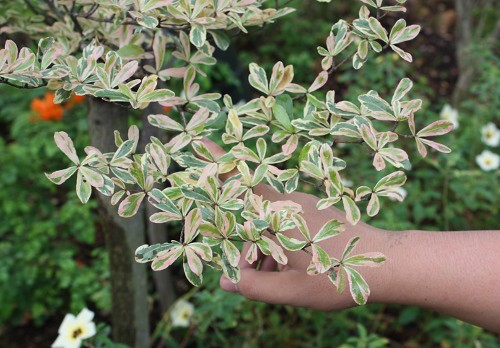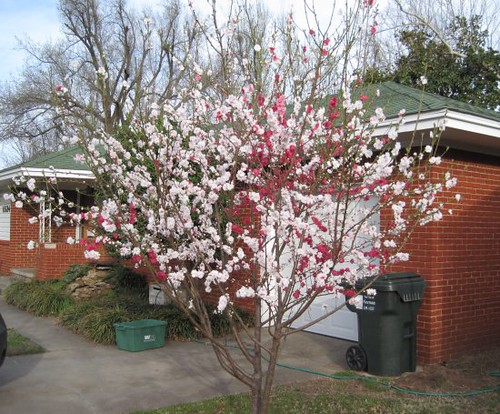Even though much of Gardens by the Bay has just recently been planted, the garden planners went all out to purchase mature trees from all over the world. For example, check out the size of this Cannonball tree!
 |
| Couroupita guianensis, the Cannonball tree |
Yes, I have seen a
larger one, but it must have been in place for a hundred years or more. The tree at Gardens by the Bay was just planted! So, you can see it is just starting to bloom. Soon it will have cannonballs all over the trunk.
 |
| Coccoloba rugosa, the Red-Flowered Sea Grape |
In one grove of trees there were a couple of really neat, large leaved trees.
Coccoloba rugosa, the Red-flowered Sea Grape, was a tall skinny tree, with large, round leaves and blooms emerging from the top.
 |
| Coccoloba rugosa flowers |
Another large-leaved tree is
Macaranga grandiflora, the Parasol Leaf tree.
 |
| Macaranga grandiflora, Parasol Leaf tree |
The Silk Floss tree (
Ceiba speciosa) is one that I am familiar with from the Myriad Gardens. The most prominent feature of this tree (when not in bloom) is the large thorns covering the trunk of the tree. One area of the gardens is planted with a bunch of
Ceiba. It is curious to me that some trunks are covered in thorns and others are almost entirely smooth.
 |
| Grove of Ceiba speciosa (Silk floss) trees |
In bloom, this tree has beautiful pink flowers. After the blooms are pollinated, they produce seed pods that open to reveal some fluffy silk-like threads surrounding the seeds. This is where it gets its common name.
 |
| Ceiba speciosa flower |
Another tree with nice flowers was a
Jatropha. Does anyone know what species this is? It has really neat leaves to accompany the vibrant orange flowers. [Update 2012-09-04: Tom commented that this is probably
Jatropha podagrica. Thanks Tom!]
 |
| Jatropha podagrica with orange blooms |
 |
| Theobroma cacao |
The cacao (chocolate) tree,
Theobroma cacao, will start blooming and producing fruit at a small size. That's good news, because this tree is only about 8 feet tall.
 |
| Beautiful layered tree, Terminalia mantaly 'Tricolour' |
One of my favorite trees in the outdoor gardens was this beautiful tree (
Terminalia mantaly 'Tricolour') that naturally grows in layers. The leaves are patterned in white, green and a touch of pink.
 |
| Colorful leaves of the layered tree, Terminalia mantaly 'Tricolour' |
From a distance, I thought this next tree was blooming or had hanging fruit. As I approached, I realized it was just the new emergent leaves that hang down and reflect light with their glossy texture.
 |
| Tree with conspicuous emergent leaves |
Until my trip to Singapore, I thought
Pandanus was a genus only consisting of large, stilt-root trees. While at the gardens, Shawn pointed out several small plants and shrubs that he said were
Pandanus. One tree that I
knew was
Pandanus was this large tree.
 |
| Pandanus tree |
The last "trees" I will show you are not living trees, exactly. They are the gigantic metal "supertrees" which are visible from anywhere in the gardens. They are covered with bromeliads and other epiphytes, which will fill in over time.
 |
| Under the Supertrees |
Due to the overcast sky, I really couldn't get a good photo of these trees, but here are some highly backlit photos anyway.
 |
| The Supertrees under a rainy sky |













































